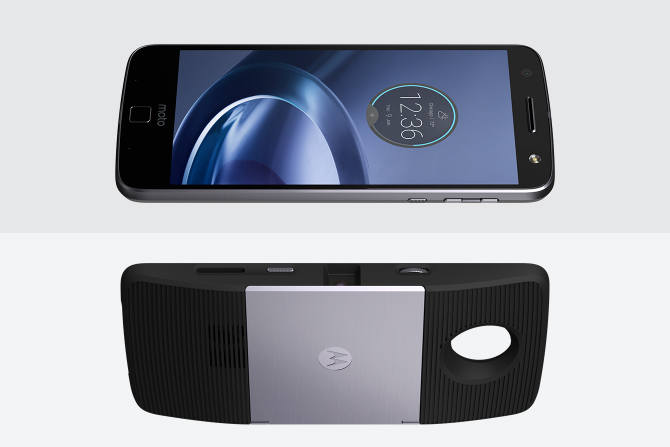Reinventing the Smartphone: The Rise of Modular Phones

image credit: screenshot via Motorola Z website
When it comes to smartphone designs, it’s been a pretty boring couple of years. More or less, we only get to see the same designs over and over— rectangular touchscreens with a camera at the back and at times, a camera at the front. Unlike the era when Nokia dominated the mobile phone market, we got to see a lot of different phone designs: bar phones, clamshells, sliders, and other quirky designs that made you stand out of a crowd.
Well, to those who’ve been familiar with that generation, it’s good to reminisce. But the same time, we’re now looking at a future where smartphones may just undergo a major design revamp. Say hello to “modular phones.”
Modular phones have made its debut this 2016, from various electronics shows to the Google I/O Summit in California. It’s starting to shift the trend as add-on components are being introduced to mobile phones. It basically opens up customization where you are not tied to the fixed specifications of your phone. As such, the technology allows the flexibility and adaptability of a smartphone.
This year, the buzz is all about three major releases: Motorola’s Moto Z, the LG G5, and the developer version of Google’s Project ARA. The three gadgets seem to be making waves in the tech market and let’s take a dive in each.

image credit: screenshot via LG G5 website
LG G5
The Korean-based tech company LG, has recently debuted its competitor to the Samsung Galaxy series and Apple’s iPhone. The G5 model is not just an upgrade to the previous G series, it’s adding a ‘modules feature’ called “friends”. Basically, LG included additional gadgets that can be equipped to the LG G5. The bottom part of the phone can be dislodged and replaced with a different module or “friend”.
Right now, the G5’s got only one “friend” and it’s the LG G5 Cam Plus. The Cam Plus can be locked in at the bottom of the G5 to transform the phone into a fully functional point-and-shoot camera. The Cam Plus does not enhance the camera of the G5 per se, but it does add some buttons to make photo-snapping easier. The module has a zoom dial, dedicated record button, and a shutter button that imitates the feel of a camera. It also adds a little width to the phone so gripping the G5 would be easier while snapping some memories.
Too bad though, there’s only one LG “friend” right now. According to Android Central, another module for the G5 will be released soon in collaboration with sassy tech brand Bang and Olufsen. The LG G5 Hi-fi Plus is their take of an enhanced audio module, sort of a souped up speakers for the phone perhaps.
Moto Z
Another recent take on modular phones is Motorola’s Moto Z line. On the surface, the Moto Z looks just like any smartphone we’ve seen. But wait until you get your hands on the Moto Mods! Unlike the LG G5, the moto Z has three Moto mods that the user can swap with. And the cool thing here is that you don’t have to detach anything from the phone. Strong magnetic strips snap the modules right at the back of the phone.
If you want to amplify your music or transform your Moto Z into a boom box, then just attach the JBL Sound Boost Moto Mod. It has built-in kickstand to transform your phone into a mini-music player and it adds 10 more hours of battery life. The second Moto Mod is actually a cool one as you can project photos and videos right from your phone! The Insta-share Projector Moto Mod allows you to project up to a wall or any surface for that matter, up to 70 inches. That’s pretty awesome for a smartphone, right? The third Moto Mod is great for people who are annoyed with power banks. If you are in need of additional power, just snap in the Incipio offGRID Power Pack which gives an additional of 22 whopping hours of power.

image credit: screenshot via Google Project ARA website
Project ARA
The third one to hit the tech market is the most customizable modular phone of the three, Google’s Project ARA. The developers have basically clarified that it’s not a new Google phone but a project that would test the feasibility of a smartphone that’s fully customizable with modules. Project ARA features a touchscreen front with a backside frame where you can slide on or off different modules or “shells” as they call it.
Each module has a certain function to the point that the camera and speakers can be detachable from the device. Users can mix and match modules depending on their activity. When you’ll go jogging, you can swap your camera module for a pedometer module for example. The team is still in the middle of developing modules and it’s pretty much open for people who want to collaborate. The developer version of the device is bound to drop by autumn of this year.
With these developments on the rise, it seems that smartphones are heading towards a more diverse and flexible future. If it wants to stay smart, then it has to be able to adapt to the changing lives of people. Of course, there is a need to standardize the way modules are made, if we want this to be truly successful. But for now, each tech company seems to be painting a future that is both exciting and different from the smartphones we’ve gotten used to.